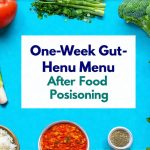Recovering from a stomach bug, food poisoning, or even a period of intense nausea can leave you feeling vulnerable and anxious about reintroducing foods. It’s completely normal to feel hesitant; your body has just gone through something stressful, and it needs time to heal. The immediate aftermath often involves bland diets and cautious sipping, but the transition back to normal eating is where many people struggle. This isn’t simply about tolerating food again – it’s about rebuilding your relationship with food and regaining confidence in your digestive system. It’s a process that requires patience, self-awareness, and a gentle approach.
The key takeaway here is that there’s no one-size-fits-all timeline or diet plan. Everyone experiences these episodes differently, and their recovery will vary accordingly. What worked for a friend might not work for you. This article aims to provide guidance and practical tips to help you navigate this transition, focusing on mindful reintroduction of foods and recognizing your body’s signals. It’s about listening intently to what your body is telling you, rather than adhering rigidly to strict rules or pre-defined lists. Remember that setbacks are normal – they don’t indicate failure, just a need to adjust the pace. Perhaps exploring eating mindfully will help with this process.
Reintroducing Foods: A Gradual Approach
The most common mistake people make after a stomach episode is attempting to return to their regular diet too quickly. This can overwhelm your digestive system and potentially trigger relapse of symptoms or prolonged discomfort. The goal isn’t to rush back to everything you enjoyed before, but rather to systematically reintroduce foods in a way that allows your gut to adapt. Start with the basics – easily digestible options that are gentle on the stomach. Think beyond just bland; while crackers and toast have their place initially, they don’t provide much nutritional value for sustained recovery.
A good starting point is the BRAT diet (Bananas, Rice, Applesauce, Toast), but it shouldn’t be considered a long-term solution. It lacks essential nutrients. Instead, use it as a stepping stone. Begin with small portions of these foods and gradually add others based on your tolerance. For example, if you tolerate rice well, you could introduce plain yogurt or boiled potatoes. Pay close attention to how your body responds after each new addition. If you experience bloating, gas, nausea, or diarrhea, it’s a signal to scale back and reassess. Don’t feel discouraged; it simply means that particular food wasn’t ready for reintroduction yet. Understanding sensitive stomachs can also inform your choices here.
Consider the texture of foods as well. Pureed or soft foods are generally easier to digest than raw vegetables or fibrous fruits. As your tolerance improves, you can gradually increase the complexity and variety of your diet. Remember to stay hydrated throughout this process; water is crucial for digestion and overall recovery. Electrolyte-rich beverages can also be helpful, especially if you experienced significant fluid loss during your illness.
Understanding Your Digestive Signals
Your body is incredibly adept at communicating its needs – often through subtle signals that we overlook in our busy lives. After a stomach episode, it’s even more important to tune into these cues. These aren’t just about obvious symptoms like nausea or diarrhea; they include things like changes in energy levels, bloating after specific foods, increased gas production, or even shifts in your bowel movements. Paying attention to these signals is key to personalized recovery.
- Keep a food diary: This can be incredibly helpful for identifying trigger foods and tracking your progress. Note what you eat, when you eat it, and how you feel afterward.
- Start small: Introduce one new food at a time, allowing several days to assess your tolerance before adding another.
- Listen to your gut (literally): If something feels off, stop eating it and revert to more easily digestible options.
It’s important to differentiate between normal digestive processes and signs of intolerance. Occasional gas or mild bloating is common, but persistent or severe symptoms warrant caution. Don’t push yourself if you’re feeling unwell; rest and allow your body time to heal. This isn’t about being overly cautious, it’s about respecting your body’s limitations and avoiding unnecessary discomfort. Sometimes a cheat day can derail progress, so be mindful!
The Role of Probiotics & Gut Health
The digestive system relies on a complex ecosystem of bacteria known as the gut microbiome. A stomach episode can disrupt this delicate balance, potentially leading to ongoing symptoms or increased susceptibility to future issues. While probiotics aren’t a magic bullet, they can play a supportive role in restoring gut health and promoting efficient digestion. Probiotics are live microorganisms that, when consumed in adequate amounts, confer a health benefit on the host.
- Food sources: Fermented foods like yogurt (with live cultures), kefir, sauerkraut, and kimchi naturally contain probiotics.
- Supplements: If you choose to take a probiotic supplement, consult with a healthcare professional to determine the appropriate strain and dosage for your needs. Not all probiotics are created equal.
- Prebiotics: Don’t forget about prebiotics – these are types of fiber that feed the beneficial bacteria in your gut. Sources include garlic, onions, bananas, and oats.
It’s crucial to remember that rebuilding gut health is a gradual process. Probiotics aren’t an instant fix; they require consistent intake and a supportive diet to thrive. Focus on incorporating probiotic-rich foods into your diet regularly and consider supplementing if needed, but always prioritize whole, unprocessed foods as the foundation of your recovery. Grain-free diets can impact gut health too, so be aware.
Hydration & Electrolyte Balance
During a stomach episode, you likely lost significant fluids through vomiting or diarrhea. Rehydration is paramount, but it’s not just about drinking water. You also need to replenish lost electrolytes – minerals like sodium, potassium, and magnesium that are essential for proper bodily function. Dehydration can exacerbate symptoms and hinder recovery.
- Water: Drink small, frequent sips of water throughout the day rather than large amounts at once, which can overwhelm your stomach.
- Electrolyte solutions: Consider electrolyte-rich beverages like oral rehydration solutions or coconut water. Avoid sugary sports drinks, as they can sometimes worsen diarrhea.
- Food sources: Certain foods naturally contain electrolytes, such as bananas (potassium), spinach (magnesium), and broth (sodium).
Monitor your urine color; pale yellow indicates adequate hydration, while dark yellow suggests you need to drink more fluids. Pay attention to how you feel – dizziness, fatigue, and muscle cramps can be signs of dehydration or electrolyte imbalance. If you’re struggling to stay hydrated, consult with a healthcare professional for guidance. Remember that proper hydration is foundational to digestive recovery. Returning from vacation can also disrupt hydration and digestion!
It’s important to remember that returning to normal eating after a stomach episode isn’t about willpower or forcing yourself to eat. It’s about patience, self-awareness, and a gentle approach. Listen to your body, prioritize hydration and gut health, and gradually reintroduce foods based on your tolerance. Don’t hesitate to seek guidance from a healthcare professional if you have concerns or experience persistent symptoms. Ultimately, the goal is not just to get back to eating, but to rebuild your relationship with food and regain confidence in your digestive system. Planning for the future can help manage anxiety around health too. Finally, consider walking after eating to aid digestion.


















